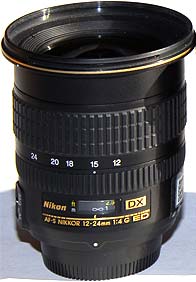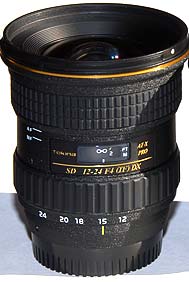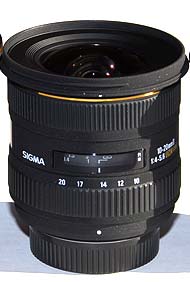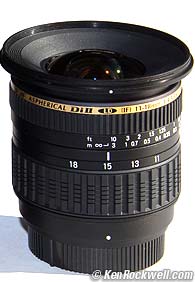Home Search Gallery How-To Books Links Workshops About Contact
Distortion
© 2006 KenRockwell.com
 |
 |
 |
 |
Nikon 12 - 24
mm f/4, Tokina 12 - 24 mm f/4, Sigma 10 - 20 mm f/4 - 5.6 and Tamron
11 - 18 mm f/4.5 - 5.6.
Click an image to get it from Adorama.
Also try Amazon.
It helps me if you get yours at either one.
|
Most people will never notice distortion with most subjects. You only see it if you have long, straight lines running parallel to the edges. It shows up as slight curvature. I have to go out of my way to find things to photograph to show this. These lenses are surprisingly similar. They usually have some complex barrel distortion at their wide ends, are flat in the middle of the range and have just a hint of pincushion at their long ends. It takes a lot of computer power to calculate all the numbers below for use in PhotoShop CS2's Lens Distortion filter to correct the distortion. I had to buy a new Quad G5 and took an afternoon to tweak, save and organize all the examples. Now that I've published the figures they're easy to plug into the filter even on my 12" laptop. Please use and enjoy these figures for your photography. Remember that these articles are copyrighted and registered so please don't use them in your own book or review without permission. Please feel free to link back to this page instead. A positive number means barrel distortion. A negative number means pincushion. Smaller is better. See my page on Correcting Lens Distortion to learn how to use these numbers to correct the distortion. "Complex" distortion means that the curvature is more complicated than a simple curved line. Some people call this "moustache" distortion. PhotoShop CS2's filter only corrects simple (first order) distortion. If the distortion is complex it won't correct completely in CS2. I mark these with an asterisk. If you need absolute rectilinearity just shoot the lenses in their neutral range, get a view camera, or investigate some of the more complicated correction software like Panorama Tools. The great news is that the Tokina corrects perfectly at every focal length. Distortion doesn't vary with aperture. It can vary with distance. These were tested at infinity. Values of 1 or less are pretty much invisible. Values of 3 and greater are easy to see if you're looking for them on straight lines near the edges. Measurements
* Complex. ** Really complex. Best correction doesn't fix the corners. Discussion Nikon I own the Nikon. Distortion is insignificant except at 12 - 14 mm. At 12 - 14 mm the corners will curve in a bit. It's worst at 12 mm. The center section is still undistorted. This complex distortion at the wide end is hard to correct in PhotoShop. The center is affected if you use enough correction to fix the sides. Tokina The Tokina has about the same amount of distortion as the Nikon at 12 mm. The Tokina's distortion is simple and therefore easy to correct. This is better than my Nikon if you do corrections. This is great if you do corrections: it's the only lens here that allows complete distortion correction. The Canon 10 - 22 mm also allows complete distortion correction in CS2. Midrange the Tokina still has some distortion. It's easy to correct completely. At 24 mm the Tokina has zero distortion, the only lens to do so. I see nothing even at 100% on my 30" display with a PhotoShop ruler next to it. Sigma The Sigma is a roller coaster ride at 10 mm. It can't be corrected well in PhotoShop's Lens Distortion Correction filter. It's pretty good in the middle of the image, but the sides curve in more strongly than any other tested lens. At 12 mm it's pretty good and can be left alone. It's still a bit wavy if you look too closely. It can't be corrected in the Lens Distortion Filter. The pincushion distortion at the longer settings is easy to correct. Tamron Unlike any of the others, the Tamron's distortion is almost the same at every focal length. Backwards from the Sigma and Nikon, it tends to bow out in the middle and become straight at the sides. This again makes it hard to correct. Without correction the Tamron is the least obnoxious of these lenses at the wide end. With correction there is always a little bit of waviness left over. Examples Here are crops of the thin line of the La Jolla horizon. Here's a full image as a guide:
La Jolla Coast. (Sigma at 10 mm. Barrel distortion causes the sides to tilt down.) Each of these below is just the top 8% of the frame. It's the complete image horizontally. Please ignore exposure and color variations between lenses and focal lengths. As angles of view change the best overall exposure and auto white balance changed, which makes the exposure and color for just the top strip change, too. NIKON Uncorrected
Corrected per table in PhotoShop CS2's Lens Distortion Filter
TOKINA Uncorrected
Corrected per table in PhotoShop CS2's Lens Distortion Filter
SIGMA Uncorrected
Corrected per table in PhotoShop CS2's Lens Distortion Filter
TAMRON Uncorrected
Corrected per table in PhotoShop CS2's Lens Distortion Filter
Other Software for Correction I use Photoshop CS2 as of 2006. There are more complex programs for correcting distortion, for instance, PTLens. One reader repeated all my tests using PTLens and posts the results here. Summary If you have no computer I'd suggest the Tamron or Tokina. They are the least obnoxious without correction. Presuming you have a computer the Tokina wins, because it's distortion is easily correctable, and not bad to begin with. My Nikon is second from last. It corrects easily at mid and long settings, but is a bear at 12 mm. The Sigma isn't that bad at 12 - 20mm, but it's still last compared to the others. Skip the Tamron if you're hoping to correct it in PhotoShop. Al of these are reasonably good. There is more distortion in the Nikon 18 - 70 mm at 18 mm than in any of these. Next: Drop and Impact Test
|
Home Search Gallery How-To Books Links Workshops About Contact


